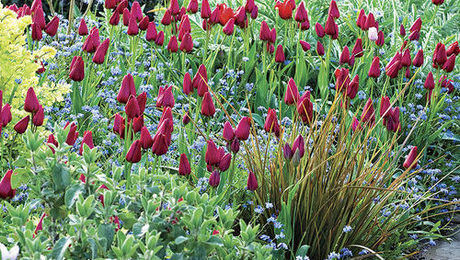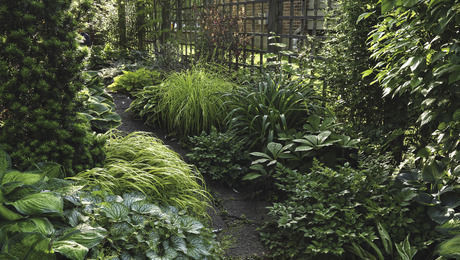What would spring be without daffodils and tulips? Despite their beauty, the same bulbs can get a little boring year after year. By adding a few special, colorful, and often underused bulbs, the “wow” can be put back into your garden. You can get sizzling colors and textures without a lot of extra effort or added cost.
There are tons of unusual and amazing bulbs available. Get off the ordinary garden freeway—where everyone plants the same species—and venture out onto the scenic back roads, where extraordinary bulbs can put the spark back into your garden.
Take no-mow zones from frumpy to fabulous


Name: ‘Charlotte Bishop’ starflower (Ipheion uniflorum ‘Charlotte Bishop’)
USDA Hardiness Zones: 5 to 9
Size: 6 to 8 inches tall
Bloom time: Early to late spring
Conditions: Full sun to partial shade; average, well-drained soil; dry soil during summer dormancy
With its calming, rose pink color, ‘Charlotte Bishop’ starflower makes a fabulous edging for borders. It produces small, sweetly fragrant flowers atop grasslike leaves. It looks great with other plants and works well around the base of trees where mowing would be difficult. Flowers can also be used to decorate the grass of chemical-free lawns. If stepped on, it smells a bit like garlic, which helps keep the critters away. In some situations, plants can reseed—a real plus in meadow-type gardens. Another special quality of this flower is that it blooms for almost the entire spring.
This beauty plays well alone and with others


Name: Blue Danube camassia (Camassia leichtlinii ssp. suksdorfii ‘Blauwe Donau’)
Zones: 3 to 8
Size: 2 to 3 feet tall
Bloom time: Late spring
Conditions: Full sun to partial shade; moist, well-drained soil
Blue Danube camassia is eye candy because of its dark blue color, a rare find among the more common pastel blues of spring bulbs. A terrific bridge flower, it blooms between the big spring show and the summer splash of color. Its flowers atop tall stems create quite a stir, whether planted alone, in mass, or intermingled with other sun-loving flowers. This plant is also content in damp spots.
Fulfill your penchant for pastels


Name: ‘Valerie Finnis’ grape hyacinth (Muscari armeniacum ‘Valerie Finnis’)
Zones: 4 to 8
Size: 6 to 8 inches tall
Bloom time: Mid- to late spring
Conditions: Full sun; moist, well-drained soil
‘Valerie Finnis’, one of the larger cultivars in its family, has long-lasting, tightly formed flower clusters. Extremely versatile, it can be planted alone or as part of a larger display. You’ll often find this and other varieties of Muscari planted in large quantities to resemble a river. Bulbs are inexpensive and need to be planted only 2 to 4 inches deep, and the resulting flowers can really spice up a garden.
Large masses of blue-flowered bulbs, especially dark blue, can mimic a dramatic “river” in the spring landscape.


Name: ‘Excelsior’ Spanish bluebell (Hyacinthoides hispanica ‘Excelsior’)
Zones: 4 to 10
Size: 6 to 16 inches tall
Bloom time: Late spring
Conditions: Full sun to partial shade; average, well-drained soil
I love this bulb in the garden not only because of its color but also because of its strength and vibrancy. ‘Excelsior’ Spanish bluebell looks amazing with blooming azaleas (Rhododendron cvs., Zones 5–9), dogwoods (Cornus spp. and cvs., Zones 2–9), and viburnums (Viburnum
spp. and cvs., Zones 3–9), and makes a terrific cut flower. Its linear leaves are sturdy, and the bulb spreads underground by runners to form nice clumps. Many varieties of Spanish bluebell will also reseed and naturalize into drifts. I’ve even seen them looking like a carpet in dappled deciduous woods. It is an adaptable bulb and, for me, has proven to be critter resistant.
Looking for amazing color


Name: ‘Spring Valley Hybrids’ foxtail lily (Eremurus ‘Spring Valley Hybrids’)
Zones: 5 to 8
Size: 3 to 8 feet tall
Bloom time: Late spring
Conditions: Full sun; moist, fertile, well-drained soil
‘Spring Valley Hybrids’ foxtail lily is a mix of several different hybrids grown from seed and propagated for cut flowers. The blooms make these plants the star of late-spring gardens. With their tall stems—some bearing up to 500 florets in shades of white, pink, yellow, or orange—they tower over every other flower. Planted against a dark background, their color and height is even more effective, appearing like tall garden sculptures. Their bulbs, which look a bit like an octopus, should be planted on a raised mound of soil to provide good drainage.
If you’re looking for something unique, voodoo lily hits the spot


Name: Voodoo lily (Dracunculus vulgaris)
Zones: 6 to 9
Size: 1 to 3 feet tall
Bloom time: Late spring
Conditions: Full sun to partial shade; average soil
Voodoo lily is so unusual that special cocktail parties have been planned around its bloom time. Each plant has a huge, reddish black spike surrounded by a similarly colored spathe, which makes it look like it has grown its own vase. The bloom briefly (about a day or two) stinks like rotting meat and attracts pollinating flies and beetles. A leopard-spotted stem supports large variegated leaves, which spread out like a fan. Red berries emerge during summer when the bloom dies back, making it a two-season plant. Voodoo lily looks its best in tropical gardens or toward the back of flower borders.
This bulb is the “little black dress” of springtime


Name: ‘Gravetye Giant’ summer snowflake (Leucojum aestivum ‘Gravetye Giant’)
Zones: 3 to 9
Size: 2 to 3 feet tall
Bloom time: Early spring
Conditions: Full sun to partial shade; rich, moist soil
This is a fabulous critterproof, moisture-tolerant, long-lasting flower. Its hanging white bells begin blooming in early spring and continue with new florets for many weeks. It is one of the most adaptable favorites at our nursery. Because its bells are white, summer snowflake works well with any color scheme—from soft pastels to hot, vibrant tones. It also blooms as nicely in a sunny flower border as in a damp, shady spot. When it’s happily growing, it spreads itself around.
Add an early-season splash of color

Name: ‘Blue Giant’ glory of the snow (Chionodoxa forbesii ‘Blue Giant’)

Zones: 3 to 8
Size: 4 to 8 inches tall
Bloom time: Early spring
Conditions: Full sun to partial shade; rich, well-drained soil
Glory of the snow, in various shades of blue, pink, or white, is one of the earliest bulbs to usher in spring. ‘Blue Giant’ is one of my favorites because it’s a bit larger and stronger than the regular types and its color is so alluring. Planted in the right spot, this bulb can naturalize to create a wonderful carpet. My husband and I planted a river of it in our chemical-free lawn, where it greets us every time we walk in and out of the house. It’s also a treasure when combined with other bulbs and plants, and makes a great companion plant for around the ankles of larger, early-blooming bulbs.
Essentials for spring-bulb success
You paid your money; now, you want to see your spring bulbs bloom—not rot in the ground or get eaten by animals. Follow this simple advice to get your bulbs established and to keep them going throughout the season.
- Know when to plant. All the bulbs in this article need winter temperatures in order to bloom and should be planted in fall. The best time to plant is after you’ve had your first killing frost but before the ground freezes. In Zones 8 and warmer, bulbs may need precooling before they will bloom. But each pocket of earth is unique, so there is no definite way to determine, for certain, that your bulbs will need precooling without testing it yourself.

- Steer clear of bulb rot. Two major spring-bulb mistakes invite bulb rot to rear its ugly head. Drainage is the first concern. Site your bulbs in well-drained soil. If you don’t have it, get it by amending the planting site with compost, or plant in mounds or raised beds to promote drainage. Too much water is also dangerous, but it’s especially harmful when the roots are not yet active. Water only when needed, and keep your sprinkler system off the automatic setting.

- Keep the critters away. Even with all the new products available, the best solution for keeping pests, like deer and voles, away is to plant things they don’t like to eat. If you’re not satisfied with limiting yourself, animal repellents work well. Apply repellents by putting the bulbs in a plastic bucket; using rubber gloves, spray the bulbs before planting them. Reapply repellent after the plants emerge to protect tasty new foliage.

Becky Heath is co-owner of Brent and Becky’s Bulbs in Gloucester, Virginia.
SOURCES
The following mail-order plant sellers offer the widest selection of the bulbs featured:
Brent and Becky’s Bulbs, Gloucester, Va.; 877-661-2852; www.brentandbeckysbulbs.com
McClure & Zimmerman, Friesland, Wis.; 800-546-4053; www.mzbulb.com
White Flower Farm, Litchfield, Conn.; 800-503-9624; www.whiteflowerfarm.com
Photos, except where noted: Steven Cominsky, Brent and Becky Heath, Joshua McCullough, PhytoPhoto, Susan A. Roth, Danielle Sherry, Michelle Gervais
Fine Gardening Recommended Products

Gardener's Log Book from NYBG
Fine Gardening receives a commission for items purchased through links on this site, including Amazon Associates and other affiliate advertising programs.

A.M. Leonard Deluxe Soil Knife & Leather Sheath Combo
Fine Gardening receives a commission for items purchased through links on this site, including Amazon Associates and other affiliate advertising programs.

The New Organic Grower, 3rd Edition: A Master's Manual of Tools and Techniques for the Home and Market Gardener, 30th Anniversary Edition
Fine Gardening receives a commission for items purchased through links on this site, including Amazon Associates and other affiliate advertising programs.


















Comments
Log in or create an account to post a comment.
Sign up Log in